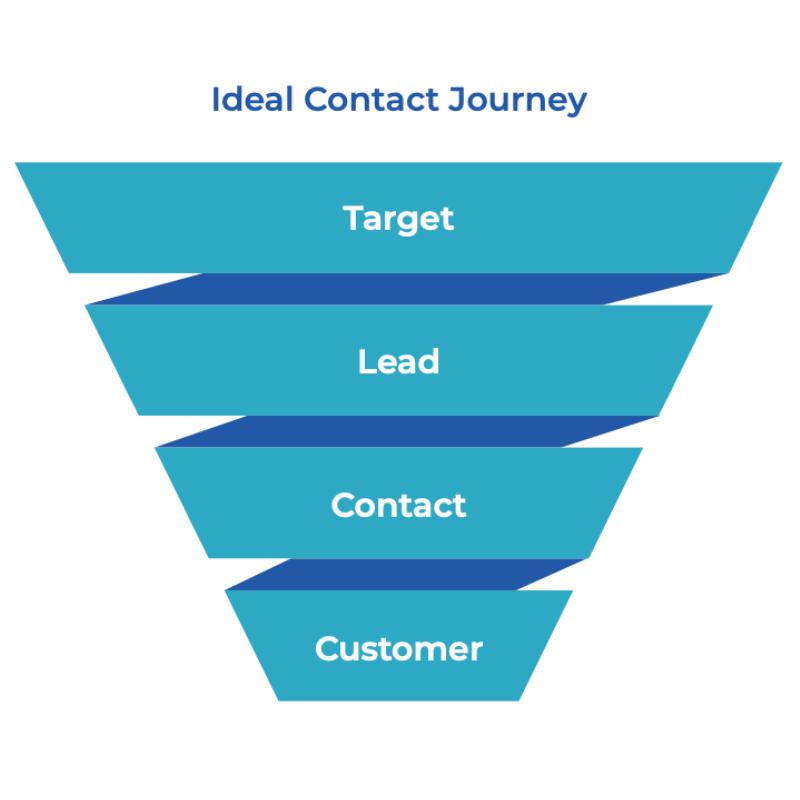Smart Start: No Sales Team, No Problem: 5 Ways to Follow Up with Leads

In this guide, you’ll learn about the different types of leads, the importance of lead generation, and five tactical lead follow-up tips you can implement today.
Targets vs. Prospects vs. Leads: What’s the difference?
Targets, and prospects, and leads, oh my!
If you’re a small business owner, the thought of effectively managing your leads without the help of a dedicated sales team can feel overwhelming. Adding lead management to your already mile-long to-do list probably seems impossible.
We get it! That’s why in this Smart Start, we’re getting back to basics and sharing easy-to-implement tips you can use to effectively organize and nurture your leads.
But first, let’s talk about a few important definitions.
Targets - The popular adage “Everyone isn’t an audience” applies to lead generation, too. When developing a strategy, take time to zero in on who you’re trying to reach, what they’re interested in and why they would benefit from your brand’s products or services. Understanding your target audience at this level will help you refine your approach to attract their attention and into your sales funnel.
Leads - A lead is a person or organization that expresses interest in a product/service a company’s selling by sharing contact information such as their full name, email address, phone number and organization name. Leads are an unqualified contact and fall under this category because they typically don’t understand what exactly they need, how your company can help, or they can’t quite justify the cost of your product/service just yet.
Prospects - Simply put, a prospect is a qualified contact. Prospects are potential customers that align with certain criteria a company has decided make them a good fit for their product or service. Examples of prospect criteria can include demographics, job title, company size, industry and location.

What is Lead Generation?
Lead generation is the process of identifying, attracting and developing relationships with consumers to potentially convert them into customers.
Why is Lead Generation Important?
Let’s rewind the clock a bit and go back to the day you started your business.
Now imagine starting your business and not telling anyone. If you opened a physical brick and mortar, it’d be like locking the doors, turning off the lights and drawing the blinds. If it’s an online business, there wouldn’t be any keywords on your website, no social media channels to attract attention and no indexed pages on the internet.
Nothing.
As a result, no one would know about you and in turn, you’d generate zero business. The end to this horror story is pretty apparent - Your company wouldn’t succeed.
Brands need leads to stay in business.
Brands that don’t deploy lead generation efforts are in the same boat. They have a viable business but they’re not attracting the eyeballs of the people that matter most to their bottom line – their target audience.
Lead generation efforts are like the bait that hooks their attention. What you do after to reel them in is what we’re discussing in this Smart Start.

How to Follow Up with Leads without a Sales Department
To set the stage, let’s assume you have lead generation strategies in place that are attracting leads into your funnel.
Leads are pouring in like shoppers at a department store as soon as the doors open on Black Friday. That’s great news, but, now what? For small businesses, this is a question that plagues them and their growth. How can small businesses keep the lead generation journey moving in the right direction and cash in on these opportunities?
Here are a few tips.
Segmentation
Segmenting your leads is a great first step in the process because it gives you the opportunity to create a personalized experience for your audience.
Think about it this way.
Let’s say you discovered an instrument shop and showed interest in their guitars. But, after that first engagement, they only shared information about their harp selection with you.
Do you think that would entice you to further your engagement with the brand and better yet, make a purchase?
Odds are it wouldn’t.
That’s why segmentation is important because it empowers brands to create unique journeys infused with valuable and relevant content consumers can follow.
There’s a lot more that goes into lead segmentation. But for now, think of lead segmentation like the Sorting Hat in Harry Potter. When a lead comes in, decide which “school” it belongs to and create messaging and touchpoints accordingly.
Track communications
When it comes to managing communication with your leads, you’ll want to channel your inner Marie Kondo and get organized.
Find an approach that sparks joy and go with it. Here are a couple of tips to consider.
For small businesses who are just getting started, create a Google Document that lists:
- The lead source - Social media, email, cold outreach, direct mail, etc.
- The contact’s information - Name, email address and/or phone number, state/city, company name, etc.
- The name of the employee assigned to the lead.
- Touches - Break your interactions down into touches and share notes on the outcomes.
Here’s an example of this approach in action:

Share this document with your team. Having a centralized location that keeps track of every touch and the consumer journey will help you avoid overlap in outreach or missing an opportunity to connect with a lead, for example.
If you feel your business is ready for a more sophisticated approach, consider investing in customer relationship management (CRM) software.
A CRM uses technology that manages a company’s leads and interactions with current and prospective customers.
Think of a CRM as the home base for your business that empowers your brand to develop and nurture relationships with leads, share pertinent information with employees, and turn prospects into customers.
Examples of CRMs include Salesforce, Hubspot, Marketo and Zoho, to name a few.
No matter what route you take, staying organized is an integral part of creating and maintaining effective and efficient lead management processes.
Create a follow-up schedule
On average, it takes eight touches to convert a lead into a sale.
Creating and sticking to a follow-up schedule will keep the lines of communication open with your leads which is pivotal in your efforts in converting them to customers.
Email marketing
If you have email newsletters or regular email outreach strategies in place, add leads to relevant email lists so they can understand your brand on a deeper level.
Benefits of email marketing for lead generation include but aren’t limited to:
- Brand awareness - Consistent email outreach is a great way for brands to stay top of mind with their subscribers. Use each touch to deepen your audience’s understanding of your brand and what you have to offer.
- Nurture - To build on the latter, deploying a segmented email marketing strategy that delivers valuable and informative content right to your subscribers’ inboxes is a great way to nurture and grow your relationships.
- Empower - And, let’s not forget sometimes people who engage with a brand are advocates/supporters, not the decision-makers. Consistent and relevant email marketing correspondences can win over the hearts and minds of your brand advocates, and in turn, their bosses through the sharing of valuable information (white papers, case studies, reports, etc.).
Expand your outreach
On their own, leads are valuable. But, what if you could do even more with them?
Enter outreach expansion efforts. That feels a bit more dramatic than necessary, but this tip is a great way to strengthen and build brand awareness with your leads.
Here’s how you do it. Take your segmented groups of leads and add them to relevant advertising campaigns. Think Google PPC and social media ads. From there, create custom audiences to find your leads on the given network.
Once you’ve completed these steps, you can serve them with relevant and topical ads. The benefit of this tactic is that repetition builds brand recognition, which in turn generates interest and in time turns leads into customers.

Get help with your press release distribution today!
Not sure what you need from a distribution partner or where to start? Newswire’s team of expert PR Strategists can conduct a free, comprehensive needs analysis to determine the right solution. In addition to press release distribution options, Newswire offers additional media and marketing communications support through the Press Release Optimizer.
Let's Get StartedDistribute the Right Message to the Right Audience at the Right Time
Do you think the Press Release Optimizer might be a good option for you? Click “Let’s Get Started” to schedule your free needs analysis to see how Newswire can support your media and marketing efforts!
